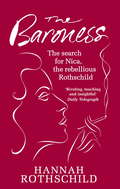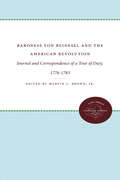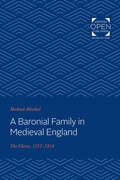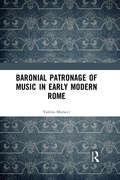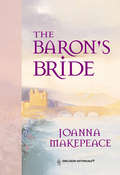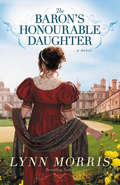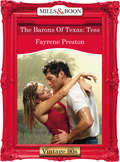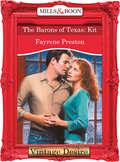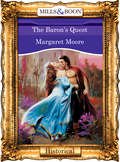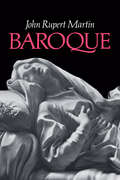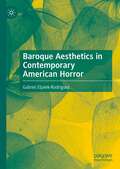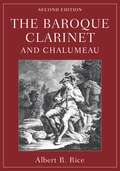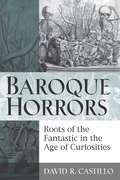- Table View
- List View
The Baroness: The Search for Nica the Rebellious Rothschild
by Hannah RothschildA Rothschild by birth and a Baroness by marriage, beautiful, spirited Pannonica - known as Nica - seemed to have it all: children, a handsome husband and a trust fund. But in the early 1950s she heard a piece by the jazz legend Thelonious Monk. The music overtook her like a magic spell, and she abandoned her marriage to go and find him. Arriving in New York, Nica was shunned by society but accepted by the musicians. They gave her friendship; she gave them material and emotional support. Her convertible Bentley was a familiar sight outside the clubs and she drank whisky from a hip flask disguised as a Bible. Her notoriety was sealed when drug-addicted saxophonist Charlie Parker died in her apartment. But her real love was reserved for Monk, whom she cared for until his death in 1982.The Baroness traces Nica's extraordinary, thrilling journey - from England's stately homes to the battlefields of Africa, passing under the shadow of the Holocaust, and finally to the creative ferment of the New York jazz scene. Hannah Rothschild's search to solve the mystery of her rebellious great aunt draws on their long friendship and years of meticulous research and interviews. It is part musical odyssey, part dazzling love story.
Baroness Orczy's The Scarlet Pimpernel: A Publishing History
by Sally DuganSince its publication in 1905, The Scarlet Pimpernel has experienced global success, not only as a novel but in theatrical and film adaptations. Sally Dugan charts the history of Baroness Orczy's elusive hero, from the novel's origins through its continuing afterlife, including postmodern appropriations of the myth. Drawing on archival research in Britain, the United States and Australia, her study shows for the first time how Orczy's nationalistic superhero was originally conceived as an anarchist Pole plotting against Tsarist Russia, rather than a counter-revolutionary Englishman. Dugan explores the unique blend of anarchy, myth and magic that emerged from the story's astonishing and complex beginnings and analyses the enduring elements of the legend. To his creator, the Pimpernel was not simply a swashbuckling hero but an English gentleman spreading English values among benighted savages. Dugan investigates the mystery of why this imperialist crusader has not only survived the decline of the meta-narratives surrounding his birth, but also continues to enthrall a multinational audience. Offering readers insights into the Pimpernel's appearances in print, in film and on the stage, Dugan provides a nuanced picture of the trope of the Scarlet Pimpernel and an explanation of the phenomenon's durability.
Baroness Orczy's The Scarlet Pimpernel: A Publishing History
by Sally DuganSince its publication in 1905, The Scarlet Pimpernel has experienced global success, not only as a novel but in theatrical and film adaptations. Sally Dugan charts the history of Baroness Orczy's elusive hero, from the novel's origins through its continuing afterlife, including postmodern appropriations of the myth. Drawing on archival research in Britain, the United States and Australia, her study shows for the first time how Orczy's nationalistic superhero was originally conceived as an anarchist Pole plotting against Tsarist Russia, rather than a counter-revolutionary Englishman. Dugan explores the unique blend of anarchy, myth and magic that emerged from the story's astonishing and complex beginnings and analyses the enduring elements of the legend. To his creator, the Pimpernel was not simply a swashbuckling hero but an English gentleman spreading English values among benighted savages. Dugan investigates the mystery of why this imperialist crusader has not only survived the decline of the meta-narratives surrounding his birth, but also continues to enthrall a multinational audience. Offering readers insights into the Pimpernel's appearances in print, in film and on the stage, Dugan provides a nuanced picture of the trope of the Scarlet Pimpernel and an explanation of the phenomenon's durability.
Baroness von Riedesel and the American Revolution: Journal and Correspondence of a Tour of Duty, 1776-1783 (Published by the Omohundro Institute of Early American History and Culture and the University of North Carolina Press)
by Marvin L. BrownThese journal accounts and letters form one of the most engaging and readable accounts of the American Revolution. Written with directness, simplicity, and charm by the wife of the commanding general of Brunswick troops in the British army, the narrative reveals the conditions in revolutionary America.Originally published in 1965.A UNC Press Enduring Edition -- UNC Press Enduring Editions use the latest in digital technology to make available again books from our distinguished backlist that were previously out of print. These editions are published unaltered from the original, and are presented in affordable paperback formats, bringing readers both historical and cultural value.
A Baronial Family in Medieval England: The Clares, 1217-1314 (The Johns Hopkins University Studies in Historical and Political Science #2)
by Michael AltschulIn A Baronial Family in Medieval England: The Clares, 1217–1314, Michael Altschul studies the Clare family during the thirteenth century. The Clares spearheaded the struggle to enforce Magna Carta in the Barons' War. Historians prior to Altschul tended to neglect the Clares' history given the scattered nature of the archives documenting their time as a politically influential and powerful family. This book unfolds chronologically, outlining the Clares' rise to preeminence and describing how they administered their estates and income.
A Baronial Family in Medieval England: The Clares, 1217-1314 (The Johns Hopkins University Studies in Historical and Political Science #2)
by Michael AltschulOriginally published in 1965. In A Baronial Family in Medieval England: The Clares, 1217–1314, Michael Altschul studies the Clare family during the thirteenth century. The Clares spearheaded the struggle to enforce Magna Carta in the Barons' War. Historians prior to Altschul tended to neglect the Clares' history given the scattered nature of the archives documenting their time as a politically influential and powerful family. This book unfolds chronologically, outlining the Clares' rise to preeminence and describing how they administered their estates and income.
Baronial Patronage of Music in Early Modern Rome
by Valerio MorucciThis is the first dedicated study of the musical patronage of Roman baronial families in the sixteenth and early seventeenth centuries. Patronage – the support of a person or institution and their work by a patron – in Renaissance society was the basis of a complex network of familial and political relationships between clients and patrons, whose ideas, values, and norms of behavior were shared with the collective. Bringing to light new archival documentation, this book examines the intricate network of patronage interrelationships in Rome. Unlike other Italian cities where political control was monocentric and exercised by single rulers, sources of patronage in Rome comprised a multiplicity of courts and potential patrons, which included the pope, high prelates, nobles and foreign diplomats. Morucci uses archival records, and the correspondence of the Orsini and Colonna families in particular, to investigate the local activity and circulation of musicians and the cultivation of music within the broader civic network of Roman aristocratic families over the period. The author also shows that the familial union of the Medici and Orsini families established a bidirectional network for artistic exchange outside of the Eternal City, and that the Orsini-Colonna circle represented a musical bridge between Naples, Rome, and Florence.
Baronial Patronage of Music in Early Modern Rome
by Valerio MorucciThis is the first dedicated study of the musical patronage of Roman baronial families in the sixteenth and early seventeenth centuries. Patronage – the support of a person or institution and their work by a patron – in Renaissance society was the basis of a complex network of familial and political relationships between clients and patrons, whose ideas, values, and norms of behavior were shared with the collective. Bringing to light new archival documentation, this book examines the intricate network of patronage interrelationships in Rome. Unlike other Italian cities where political control was monocentric and exercised by single rulers, sources of patronage in Rome comprised a multiplicity of courts and potential patrons, which included the pope, high prelates, nobles and foreign diplomats. Morucci uses archival records, and the correspondence of the Orsini and Colonna families in particular, to investigate the local activity and circulation of musicians and the cultivation of music within the broader civic network of Roman aristocratic families over the period. The author also shows that the familial union of the Medici and Orsini families established a bidirectional network for artistic exchange outside of the Eternal City, and that the Orsini-Colonna circle represented a musical bridge between Naples, Rome, and Florence.
The Baron's Bride (Mills And Boon Historical Ser.)
by Joanna MakepeaceGisela of Brinkhurst enjoyed managing her father's keep and had never thought much about marriage. Little did she foresee the threats to her father's lands and how marriage would ensure their survival.
The Baron's Honourable Daughter: A Novel
by Lynn MorrisBestselling author Lynn Morris weaves an inspirational Regency era romance rich in period detail.When her stepfather suddenly dies, Valeria Segrave finds she must take charge of her grieving mother and the vast estate which now belongs to her six-year-old half brother, the new Earl of Maledon. Though capable, Valeria is frustrated to find each day brings a new struggle as she tries to establish her authority with servants, stewards, and solicitors-all men. As a young woman with no blood relation to the earl, they are all too ready to dismiss her. Much to her chagrin, she must rely on the assistance of her stepfather's distant kinsman, Alastair, Lord Hylton. He is handsome and noble, and Valeria senses under the veneer of his gentlemanly behavior that she never measures up to his expectations of a refined lady. In light of that, accepting his help and feeling under a burden of gratitude to him is almost unbearable. Even when Valeria leaves the country estate for the glittering London Season, where she gets into a series of escapades, Lord Hylton is always there to witness, criticize, and correct her behavior. But if Alastair insists on engaging in a battle of wits and wills with the lively Valeria, she'll stop at nothing to prove that he's met his match.
The Barons Of Texas: Tess (Mills And Boon Vintage Desire Ser.)
by Fayrene PrestonLOVE AT FIRST SIGHT Tess Baron knew she was in trouble the second she laid eyes on the mysterious - and oh-so-sexy - stranger. Why had Nick Trejo suddenly appeared, asking her for a private meeting? And what was it about Nick that made Tess long to be in his arms… ?
The Barons Of Texas: Kit (The Barons #9)
by Fayrene PrestonKit Baron' s one weakness in life, her delectable step-cousin Des Baron, had become her only chance at freedom. Wrongly accused of murder, she needed his legal genius.
The Baron's Quest (Mills And Boon Vintage 90s Modern Ser.)
by Margaret MooreThe Baron DeGuerre Had Finally Met His Match Though famed for prowess in tourney and war, Etienne DeGuerre now found himself at odds in the Battle of the Sexes. For his opponent, Gabriella Frechette, was a woman of singular beauty… and single-minded resolve. One who had easily stormed his defenses, and laid siege to his unsuspecting heart
Baroque (Icon Editions Ser.)
by John Rupert MartinThis is a nonchronological introduction to Baroque, one of the great periods of European art. John Martin's descriptions of the essential characteristics of the Baroque help one to gain an understanding of the style. His illustrations are informative and he has clearly looked with a fresh eye at the works of art themselves. In addition to the more than 200 illustrations, the volume contains an appendix of translated documents.
Baroque
by John Rupert MartinThis is a nonchronological introduction to Baroque, one of the great periods of European art. John Martin's descriptions of the essential characteristics of the Baroque help one to gain an understanding of the style. His illustrations are informative and he has clearly looked with a fresh eye at the works of art themselves. In addition to the more than 200 illustrations, the volume contains an appendix of translated documents.
The Baroque: Literature and Culture in Seventeenth-Century Europe (Routledge Revivals)
by Peter N. SkrineFirst Published in 1978, The Baroque focuses on eight areas where it expressed itself most successfully. The cultural movement called baroque dominated most of the Western Europe from the late sixteenth century to the 1720s. During that long time, it went through various phases, affecting some arts, some countries more than others. There are many overlapping definitions of baroque like from a mode of European painting to a style of architecture or rather a cultural phenomenon which manifested itself most noticeably in the fine and applied arts. In this book each chapter presents a separate exploration of different interlinked facets of this vast and maze-like subject. This book is an interesting read for scholars of European literature.
The Baroque: Literature and Culture in Seventeenth-Century Europe (Routledge Revivals)
by Peter N. SkrineFirst Published in 1978, The Baroque focuses on eight areas where it expressed itself most successfully. The cultural movement called baroque dominated most of the Western Europe from the late sixteenth century to the 1720s. During that long time, it went through various phases, affecting some arts, some countries more than others. There are many overlapping definitions of baroque like from a mode of European painting to a style of architecture or rather a cultural phenomenon which manifested itself most noticeably in the fine and applied arts. In this book each chapter presents a separate exploration of different interlinked facets of this vast and maze-like subject. This book is an interesting read for scholars of European literature.
Baroque Aesthetics in Contemporary American Horror
by Gabriel Eljaiek-RodríguezThis book traces a trend that has emerged in recent years within the modern panorama of American horror film and television, the concurrent—and often overwhelming—use of multiple stock characters, themes and tropes taken from classics of the genre. American Horror Story, Insidious and The Conjuring are examples of a filmic tendency to address a series of topics and themes so vast that at first glance each taken separately would seem to suffice for individual films or shows. This book explores this trend in its visible connections with American Horror, but also with cultural and artistic movements from outside the US, namely Baroque art and architecture, Asian Horror, and European Horror. It analyzes how these hybrid products are constructed and discusses the socio-political issues that they raise. The repeated and excessive barrage of images, tropes and scenarios from distinct subgenres of iconic horror films come together to make up an aesthetic that is referred to in this book as Baroque Horror. In many ways similar to the reactions provoked by the artistic movement of the same name that flourished in the XVII century, these productions induce shock, awe, fear, and surprise. Eljaiek-Rodríguez details how American directors and filmmakers construct these narratives using different and sometimes disparate elements that come together to function as a whole, terrifying the audience through their frenetic accumulation of images, tropes and plot twists. The book also addresses some of the effects that these complex films and series have produced both in the panorama of contemporary horror, as well as in how we understand politics in a divisive world that pushes for ideological homogenizations.
The Baroque Clarinet and Chalumeau
by Albert R. RiceThe first edition of Albert R. Rice's The Baroque Clarinet is widely considered the authoritative text on the European clarinet during the first half of the eighteenth century. Since its publication in 1992, its conclusions have influenced the approaches of musicologists, instrument historians, and clarinet performers. Twenty-eight years later, Rice has updated his renowned study in a second edition, with new chapters on chalumeau and clarinet music, insights on newly found instruments and additional material on the Baroque clarinet in society. Expanding the volume to include the chalumeau, close cousin and predecessor to the clarinet, Rice draws on nearly three decades of new research on the instrument's origins and music. Discoveries include two recently found chalumeaux in a private collection, one by Johann Heinrich Eichentopf of Leipzig, and attributions based on historical evidence for three more chalumeaux. Rice furthers the discussion to recently uncovered early instruments and historical scores, which shed light on the clarinet's evolution. Most essentially, Rice highlights the chalumeau's substantial late-seventeenth and early-eighteenth century repertory, comprising over 330 works by 66 composers, and includes a more expansive list of surviving Baroque clarinet works, organized by date, composer, and tonality/range. The Baroque Clarinet and Chalumeau provides a long-awaited follow-up to Rice's groundbreaking volume, drawing from a variety of sources-including German, Italian, Dutch, Swedish, Norwegian, Danish, Finnish, Flemish, Czech, and Catalan research-to bring this new information to an English-speaking audience. With his dedication to scholarly accuracy, Rice brings the Baroque clarinet into sharper focus than ever before.
BAROQUE CLARINET & CHALUMEAU 2E C
by Albert R. RiceThe first edition of Albert R. Rice's The Baroque Clarinet is widely considered the authoritative text on the European clarinet during the first half of the eighteenth century. Since its publication in 1992, its conclusions have influenced the approaches of musicologists, instrument historians, and clarinet performers. Twenty-eight years later, Rice has updated his renowned study in a second edition, with new chapters on chalumeau and clarinet music, insights on newly found instruments and additional material on the Baroque clarinet in society. Expanding the volume to include the chalumeau, close cousin and predecessor to the clarinet, Rice draws on nearly three decades of new research on the instrument's origins and music. Discoveries include two recently found chalumeaux in a private collection, one by Johann Heinrich Eichentopf of Leipzig, and attributions based on historical evidence for three more chalumeaux. Rice furthers the discussion to recently uncovered early instruments and historical scores, which shed light on the clarinet's evolution. Most essentially, Rice highlights the chalumeau's substantial late-seventeenth and early-eighteenth century repertory, comprising over 330 works by 66 composers, and includes a more expansive list of surviving Baroque clarinet works, organized by date, composer, and tonality/range. The Baroque Clarinet and Chalumeau provides a long-awaited follow-up to Rice's groundbreaking volume, drawing from a variety of sources-including German, Italian, Dutch, Swedish, Norwegian, Danish, Finnish, Flemish, Czech, and Catalan research-to bring this new information to an English-speaking audience. With his dedication to scholarly accuracy, Rice brings the Baroque clarinet into sharper focus than ever before.
Baroque Floral Sprig Design (large print)
by RnibThis page shows the image of a Baroque design loosely based on a sprig of acanthus leaves. It is shown as purple on a light pink background. There is a locator dot shown, which will be at the top left of the page when the image is the correct way up. The Baroque style of the seventeenth and eighteenth centuries with bold, curving forms and elaborate ornamentation originated in Rome and was encouraged by the Catholic Church. This image shows a stem starting on the bottom left quarter of the page curling up and right then left and down to the top centre of the page. Curving off from this main stem to the left and right are leaves and tendrils. Many designs for fabrics and wallpaper have used elements like this, mirrored and repeated to create patterns. Baroque styles remain popular to this day.
Baroque Floral Sprig Design (UEB contracted)
by RnibThis page shows the image of a Baroque design loosely based on a sprig of acanthus leaves. It is shown as purple on a light pink background. There is a locator dot shown, which will be at the top left of the page when the image is the correct way up. The Baroque style of the seventeenth and eighteenth centuries with bold, curving forms and elaborate ornamentation originated in Rome and was encouraged by the Catholic Church. This image shows a stem starting on the bottom left quarter of the page curling up and right then left and down to the top centre of the page. Curving off from this main stem to the left and right are leaves and tendrils. Many designs for fabrics and wallpaper have used elements like this, mirrored and repeated to create patterns. Baroque styles remain popular to this day.
Baroque Floral Sprig Design (UEB contracted)
by RnibThis page shows the image of a Baroque design loosely based on a sprig of acanthus leaves. It is shown as purple on a light pink background. There is a locator dot shown, which will be at the top left of the page when the image is the correct way up. The Baroque style of the seventeenth and eighteenth centuries with bold, curving forms and elaborate ornamentation originated in Rome and was encouraged by the Catholic Church. This image shows a stem starting on the bottom left quarter of the page curling up and right then left and down to the top centre of the page. Curving off from this main stem to the left and right are leaves and tendrils. Many designs for fabrics and wallpaper have used elements like this, mirrored and repeated to create patterns. Baroque styles remain popular to this day.
Baroque Floral Sprig Design (UEB uncontracted)
by RnibThis page shows the image of a Baroque design loosely based on a sprig of acanthus leaves. It is shown as purple on a light pink background. There is a locator dot shown, which will be at the top left of the page when the image is the correct way up. The Baroque style of the seventeenth and eighteenth centuries with bold, curving forms and elaborate ornamentation originated in Rome and was encouraged by the Catholic Church. This image shows a stem starting on the bottom left quarter of the page curling up and right then left and down to the top centre of the page. Curving off from this main stem to the left and right are leaves and tendrils. Many designs for fabrics and wallpaper have used elements like this, mirrored and repeated to create patterns. Baroque styles remain popular to this day.
Baroque Horrors: Roots of the Fantastic in the Age of Curiosities
by David Castillo"David Castillo takes us on a tour of some horrific materials that have rarely been considered together. He sheds a fantastical new light on the baroque." ---Anthony J. Cascardi, University of California Berkeley "Baroque Horrors is a textual archeologist's dream, scavenged from obscure chronicles, manuals, minor histories, and lesser-known works of major artists. Castillo finds tales of mutilation, mutation, monstrosity, murder, and mayhem, and delivers them to us with an inimitable flair for the sensational that nonetheless rejects sensationalism because it remains so grounded in historical fact." ---William Egginton, Johns Hopkins University "Baroque Horrors is a major contribution to baroque ideology, as well as an exploration of the grotesque, the horrible, the fantastic. Castillo organizes his monograph around the motif of curiosity, refuting the belief that Spain is a country incapable of organized scientific inquiry." ---David Foster, Arizona State University Baroque Horrors turns the current cultural and political conversation from the familiar narrative patterns and self-justifying allegories of abjection to a dialogue on the history of our modern fears and their monstrous offspring. When life and death are severed from nature and history, "reality" and "authenticity" may be experienced as spectator sports and staged attractions, as in the "real lives" captured by reality TV and the "authentic cadavers" displayed around the world in the Body Worlds exhibitions. Rather than thinking of virtual reality and staged authenticity as recent developments of the postmodern age, Castillo looks back to the Spanish baroque period in search for the roots of the commodification of nature and the horror vacui that accompanies it. Aimed at specialists, students, and readers of early modern literature and culture in the Spanish and Anglophone traditions as well as anyone interested in horror fantasy, Baroque Horrors offers new ways to rethink broad questions of intellectual and political history and relate them to the modern age. David Castillo is Associate Professor and Director of Graduate Studies in the Department of Romance Languages and Literatures at the University at Buffalo, SUNY. Jacket art: Frederick Ruysch's anatomical diorama. Engraving reproduction "drawn from life" by Cornelius Huyberts. Image from the Zymoglyphic Museum.
